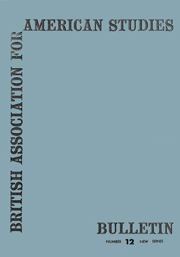No CrossRef data available.
Article contents
The Triple Graft: European Influence on American Science – 1727–1861
Published online by Cambridge University Press: 17 February 2011
Extract
Those British virtuosos who later formed the Royal Society of London, once considered (according to an eighteenth century secretary) migrating to Connecticut, “had not the Civil wars happily ended as they did.” Whether true or not, the story indicates the attraction which America offered to the early fellows. Robert Boyle was very interested in the College of William and Mary, opened in 1692, and this interest resulted in the creation of a chair of mathematics and natural philosophy. Of its nine occupants up to the Revolution, Dr. William Small, who held it from 1758–1764 was the most influential. “He fixed the destinies of my life,” wrote Jefferson. He fixed the destinies of several others in England too, for he is generally credited with initiating the Lunar Society of Birmingham on his return to England.
- Type
- Research Article
- Information
- Copyright
- Copyright © British Association for American Studies 1962


